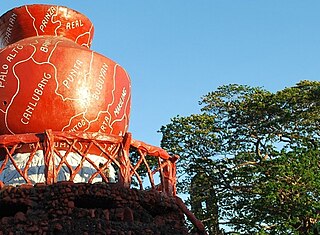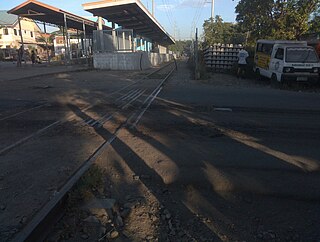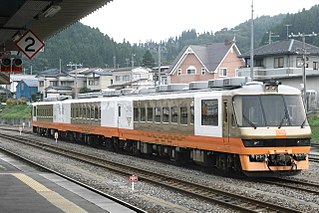
Laguna, officially the Province of Laguna, is a province in the Philippines, located in the Calabarzon region in Luzon. Its capital is Santa Cruz and the province is situated southeast of Metro Manila, south of the province of Rizal, west of Quezon, north of Batangas and east of Cavite. Laguna hugs the southern shores of Laguna de Bay, the largest lake in the country. As of the 2015 census, the province's total population is 3,035,081. It is also currently the seventh richest province in the country.

The Philippine National Railways also known as (PNR) is a state-owned railway company in the Philippines, operating a single line of track on Luzon. As of 2016, it operates one commuter rail service in Metro Manila and local services between Sipocot, Naga City and Legazpi City in the Bicol Region. PNR began operations on November 24, 1892 as the Ferrocarril de Manila-Dagupan, during the Spanish colonial period, and later becoming the Manila Railroad Company (MRR) during the American colonial period. It became the Philippine National Railways on June 20, 1964 by virtue of Republic Act No. 4156. The PNR is an agency of the Department of Transportation.

Calamba, officially the City of Calamba or known simply as Calamba City, is a 1st class city in the province of Laguna, Philippines. According to the 2015 census, it has a population of 454,486 people.

The South Luzon Expressway, formerly known as the South Superhighway (SSH), Manila South Diversion Road (MSDR), and Manila South Expressway (MSEx), is a network of two expressways that connects Metro Manila to the provinces of the Calabarzon region in the Philippines. The first expressway is the Skyway, operated jointly by the Skyway Operation and Management Corporation (SomCo) and Citra Metro Manila Tollways Corporation (CMMTC). The second expressway, the South Luzon Tollway or Alabang–Calamba–Santo Tomas Expressway (ACTEx), is jointly operated by the South Luzon Tollway Corporation, a joint venture of the Philippine National Construction Corporation and the San Miguel Corporation-backed PT Citra Marga Nusaphala Persada Tbk group of Indonesia via the Manila Toll Expressway Systems, Inc. (MATES).

Rail transportation in the Philippines presently is used mostly to transport passengers within Metro Manila and the nearby province of Laguna, as well as a commuter service in the Bicol Region. Freight transport is nonexistent, although there are plans for a revival from Port Area, Manila to Laguna, and a cargo train planned between Subic and Clark. Currently, the country has a railway footprint of only 212 kilometers (132 mi) through Line 1, Line 2, Line 3 and the Philippine National Railways' (PNR) Metro Commuter Line, although the government has stated to expand the network by 244 kilometers (152 mi) in Luzon, as well as building the 102 km (63 mi) first phase of the 1,550 kilometers (960 mi) Mindanao Railway expansion.

Mount Makiling, or Mount Maquiling, is a dormant volcano located on the border of Laguna province and Batangas on the island of Luzon, Philippines. The mountain rises to an elevation of 1,090 m (3,580 ft) above mean sea level and is the highest feature of the Laguna Volcanic Field. The volcano has no recorded historic eruption but volcanism is still evident through geothermal features like mud spring and hot springs. South of the mountain is the Makiling-Banahaw Geothermal Plant. The Philippine Institute of Volcanology and Seismology (PHIVOLCS) classifies the volcano as "potentially active".
The Legislative Districts of Laguna are the representations of the province of Laguna in the various national legislatures of the Philippines. The province is currently represented in the lower house of the Congress of the Philippines through its first, second, third, and fourth congressional districts.

Caloocan railway station is a railway station of the Philippine National Railways (PNR) as part of the Governor Pascual - FTI line. It is rebuilt from its original location, now located and situated adjacent to Apolinario Mabini St., and along the railroad crossing on Samson Road in Caloocan, Metro Manila.

The Laguna Lakeshore Expressway Dike is a proposed expressway in the Philippines that will start from the coastal area of Laguna de Bay from Taguig in Metro Manila to Calamba and Los Baños in Laguna.

San Pedro, Laguna station is a railway station on the South Main Line (Southrail) of the Philippine National Railways. Like most of the PNR stations operating under Metro South Commuter, the station is at grade. It is located in San Pedro, Laguna, within the city proper.

Pacita MG Station, also called Pacita Main Gate Station is a flagstop on the South Main Line of the Philippine National Railways. Like all PNR stations, the station is at grade. It is located in Pacita Complex 1, San Pedro City, Laguna. The flagstop currently serves the Metro South Commuter line.

Tadlac Lake, also colloquially known as Alligator Lake, is a freshwater volcanic crater lake located in Barangay Tadlac, in the municipality of Los Baños of Laguna province in the Philippines. The lake-filled maar is located along the southern shore of Laguna de Bay, the largest lake in the country, with Alligator Lake protruding out of the shore of the larger lake. If not for its slightly-elevated crater rim, Alligator Lake would be wholly engulfed by Laguna de Bay.

The Philippine National Railways Metro Commuter Line is a commuter rail line operated by the Philippine National Railways, stretching from Tondo, Manila to the southern and northern edge of Metro Manila. Presently, there are 31 railway stations. The current line is colored orange on most maps.

The KiHa 59 series (キハ59系) is a former Japanese diesel multiple unit operated by East Japan Railway Company between 1989 and 2010, and by the Philippine National Railways (PNR) on the Metro South Commuter and Isarog Express lines since 2012.

Pansol is an urban barangay in Calamba, Laguna, Philippines. It is located at the southeast edge of the city. The barangay is situated at the foot of Mount Makiling near the city's border with Los Baños and is known for its hot springs.
San Pedro-Carmona Resettlement station, often shortened to Carmona, sometimes was called General Mariano Alvarez (GMA) station was the terminus of the San Pedro-Carmona Line. The line was built to serve the San Pedro-Carmona Resettlement Center. It was located just before San Jose bridge beside the San Isidro river in GMA, San Pedro, Laguna.

The North–South Commuter Railway (NSCR), also known as the Clark–Calamba Railway, is a 148 km (92 mi) urban rail transit line being constructed in Luzon. It will run from New Clark City in Capas, Tarlac to Calamba, Laguna with 36 stations, with historic stations to be restored.

The Hybrid Electric Train (HET) is a hybrid electric train built by the Department of Science and Technology's Metals Industry Research and Development Center. The headquarters office is located at Bo. 1, Calamba, Laguna, Philippines.

IRRI is a flagstop on the Main Line South of the Philippine National Railways (PNR), located at the front gate of the International Rice Research Institute (IRRI) opposite to Pili drive, in the city of Los Baños, Laguna.
















